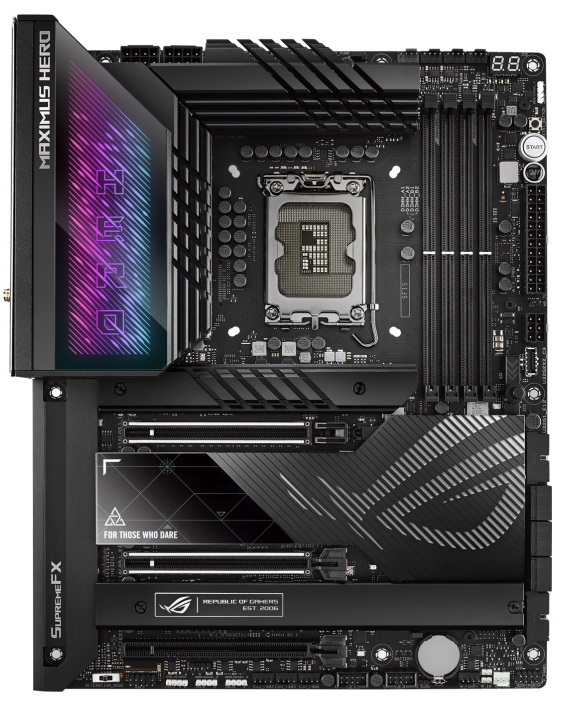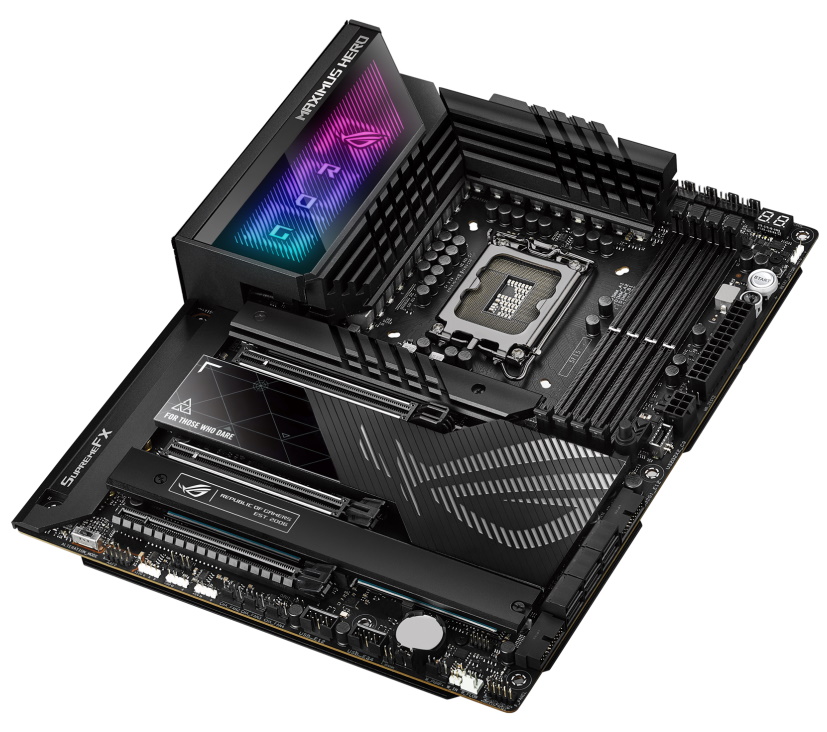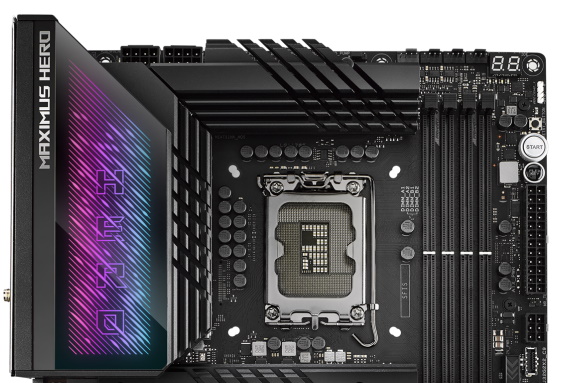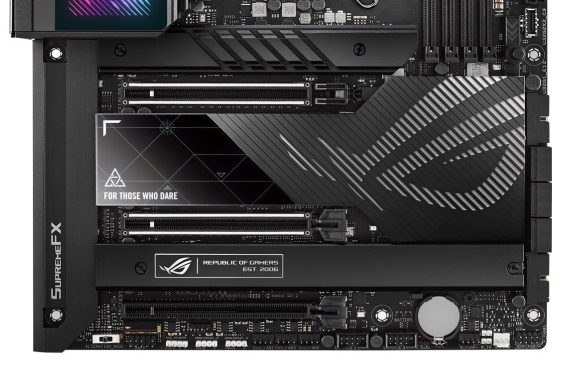Tom's Hardware Verdict
The Asus ROG Maximus Z790 Hero is a very well-built, well-equipped, and good looking motherboard. From the 40 Gbps ports to the flagship-class audio, you’re not going to find many boards that look better or have better specifications. But priced at $630, you can find boards with hardware for less.
Pros
- +
12 USB ports (two 40Gbps Thunderbolt ports)
- +
Five total M.2 sockets (including a 5.0 socket)
- +
20–Phase, 90A VRMs
- +
Flagship-class audio solution
Cons
- -
Comparably equipped boards cost less
Why you can trust Tom's Hardware
Hot off our test bench and ready for review is the Asus’ ROG Maximus Z790 Hero. Currently priced at $629.99, this premium motherboard offers a slew of features along with the classic high-end appearance found on the ROG Maximus motherboards. You get twelve USB ports on the rear IO, Thunderbolt 4 Type-C ports, five total M.2 sockets, flagship-class audio, and robust power delivery to support the latest Raptor Lake processors. Overall, it’s a good-looking and handsomely equipped option, but the high price will be a turnoff for some users.
At the time we wrote this, Asus had a total of thirteen Z790 motherboards available. You’ll find all of the familiar SKUs, including the ROG Maximus Extreme ($999), Maximus Apex ($699), The Z790-E Gaming WIFI ($499), ProArt Z790-Creator ($469), the Strix line that includes a wide variety of boards (including an ITX model). There are the more budget-conscious Prime and TUF Gaming boards as well, making this about as robust a motherboard stack as you’ll find on a single chipset.
On the hardware front, the Hero comes with everything the Z790 platform offers, and plenty of extra features. You get PCIe 5.0 slots and a PCIe 5.0 M.2 socket, the ROG Supreme FX ALC4082 codec with ESS SABRE DAC, ultra-fast 40 Gbps Thunderbolt 4 Type-C ports on the rear IO, 20-phase 90A VRMs and a sleek, modern, high-end appearance. Performance across our test suite was, on average, the best we’ve seen from our early testing on the platform. Granted, unless you’re looking at benchmarks or your stopwatch you likely wouldn’t notice a difference, but this boardstill tested well and showed it was a competent gamer, too.
With the Z790 Hero currently listed at over $600, while other similarly equipped boards are priced considerably lower, this Hero won’t make our Best Motherboards list. But is still a great option if you like the way it looks and your budget allows. Before we get into the details, including performance, we’ll start by listing the specifications from Asus’ website.
Specifications: Asus ROG Maximus Z790 Hero
| Socket | LGA1700 |
| Chipset | Z790 |
| Form Factor | ATX |
| Voltage Regulator | 21 Phase (20x 90A SPS MOSFETs for Vcore) |
| Video Ports | (1) HDMI (v2.1) |
| (2) Intel Thunderbolt 4 (Type-C) | |
| USB Ports | (2) Thunderbolt 4 Type-C (40 Gbps) |
| (1) USB 3.2 Gen 2, Type-C (10 Gbps) | |
| (5) USB 3.2 Gen 2 (10 Gbps) | |
| (4) USB 3.2 Gen 1 (5 Gbps) | |
| Network Jacks | (1) 2.5 GbE |
| Audio Jacks | (5) Analog + SPDIF |
| Legacy Ports/Jacks | ✗ |
| Other Ports/Jack | ✗ |
| PCIe x16 | (2) v5.0 (x16, or x8/x8) |
| (1) v4.0 (x4, x4/x4) | |
| PCIe x8 | ✗ |
| PCIe x4 | ✗ |
| PCIe x1 | ✗ |
| CrossFire/SLI | ✗ |
| DIMM Slots | (4) DDR5 7800+(OC)*, 128GB Capacity |
| M.2 Sockets | (2) PCIe 4.0 x4 (64 Gbps) / PCIe (up to 110mm) |
| (1) PCIe 4.0 x4 (64 Gbps) / PCIe+SATA (up to 110mm) | |
| From Hyper M.2 Card: | |
| (1) PCIe 5.0 x4 (128 Gbps) / PCIe (up to 110mm) | |
| or | |
| (2) PCIe 4.0 x4 (64 Gbps) / PCIe (up to 110mm) | |
| (NVMe supports RAID 0/1/5/10) | |
| SATA Ports | (6) SATA3 6 Gbps (Supports RAID 0/1/5/10) |
| USB Headers | (1) USB v3.2 Gen 2x2, Type-C (20 Gbps, 60W PD/QC4+) |
| (2) USB v3.2 Gen 1 (5 Gbps) | |
| (1) USB v2.0 (480 Mbps) | |
| Fan/Pump Headers | (7) 4-Pin (CPU, CPU OPT, AIO, Chassis) |
| RGB Headers | (3) aRGB (3-pin) |
| (1) AURA RGB (4-pin) | |
| Diagnostics Panel | (1) Q-Code |
| (1) Q-LED | |
| Internal Button/Switch | Start, Retry, Flex |
| SATA Controllers | ASMedia ASM1061 |
| Ethernet Controller(s) | (1) Intel (2.5 GbE) |
| Wi-Fi / Bluetooth | Intel AX201 Wi-Fi 6E (2x2 ax, MU-MIMO, 2.4/5/6 GHz, 160 MHz, BT 5.3) |
| USB Controllers | (2) ASMedia ASM1074 |
| HD Audio Codec | ROG Supreme FX ALC4082 (ESS SABREES9218 Quad DAC) |
| DDL/DTS | ✗ / DTS: Sound Unbound |
| Warranty | 3 Years |
Inside the Box of the Asus ROG Maximus Z790 Hero
The Z790 Hero includes a lot of accessories. Inside the box, you’ll find the ROG Hyper M.2 card, SATA and RGB cables, a USB drive for drivers and utilities, and a lot more items designed to make your life easier when building your system. Below is a complete list of the included accessories.
- ARGB RGB extension cable
- (4) SATA 6Gb/s cables
- ROG Hyper M.2 Card w/Heatsink
- (2) M.2 screw packages for ROG Hyper M.2 Card
- Thermal pad for M.2
- DDR5 Fan holder
- VRM Fan holder
- ASUS Wi-Fi moving antennas
- (3) M.2 backplate Q-Latch package
- (3) M.2 backplate Rubber Packages
- Q-connector
- ROG stickers
- ROG key chain
- ROG VIP card
- USB drive with utilities and drivers
- User Guide
Design of the Z790 Hero



Pulling the Hero out of the box, just by the weight you know you’re dealing with a high-quality product. The black-on-black design is built on an 8-layer PCB, with some silver accents along with branding on the heatsinks and shrouds. The heatsinks are heavy, with deep notches cooling the VRMs and a beefy heatsink to cool the top M.2 socket. There’s an RGB element above the rear IO area that illuminates some ROG branding – these are the only integrated RGBs on the board. Regardless, the Z790 Hero defintely looks the part of a high-end motherboard.
Starting with the upper left-hand corner, we get a closer look at the RGB element that has matching diagonal lines running through the display. It’s much better looking than the dot-matrix style we saw in previous generations. It isn’t terribly bright, but the colors are saturated, and it looks good. Control over this and any other RGB devices attached to the board are handled through the Asus AURA RGB software (found within Armoury Crate).
Get Tom's Hardware's best news and in-depth reviews, straight to your inbox.
The VRM heatsinks are quite heavy, have a lot of surface area with the deep miter cuts, and share the load through a heatpipe that connects the two parts. They did a great job cooling the power bits below when running our flagship Intel Core i9-13900K, as you’ll see later in the review. Along the top edge are two 8-pin EPS connectors (one required) to feed the CPU power. To the left of those is an LED that lights up if the plug isn’t connected.
To the right of the socket, we run into four unreinforced DRAM slots with a single locking mechanism up top. The Hero supports up to 128GB of DDR5, with speeds listed up to a blazing fast DDR5-7800+(OC). We didn’t have any issues with our two kits up to DDR5 6000. It’s clear, at least on paper, that there’s more headroom left. As always, your mileage may vary, so stick to the memory QVL list at extremely high speeds for the best chance of success.
Above the DRAM slots, on the top edge, are the first four (of eight) 4-pin fan headers. All of the headers support PWM- and DC-controlled devices. The CPU headers automatically select the proper mode, while the rest of the ports require manual adjustment. Both the Chassis and CPU fan headers output up to 1A/12W with the W_PUMP+ header outputs up to 3A/36W. You can control the fans through the BIOS or Armoury Crate.
Off to the right is the 2-character Q-code display and the 4-light Q-LED display. These both serve to tell you what’s going on during the board’s POST process. If something goes wrong, one of the four LEDs (CPU, Boot, VGA, RAM) will remain lit, and you’ll have a more detailed code on the Q-code showing you where the problem is.
Working our way down the right edge of the board, we run into the first (of three) 3-pin ARGB headers, as well as the Retry, Start, and Flex key buttons. Next, we hit the 24-pin ATX connection to power the board, along with a 6-pin PCIe connector. You need the PCIe power connector plugged into the board if you plan to use the 60W PD/QC4+ charging capability. Otherwise, you’re limited to 27W of charging output. Last but not least, on the top half is the front panel USB 3.2 Gen 2x2 (20 Gbps) Type-C connector.
Moving on to the power delivery, electricity flows from the EPS connector(s) and onto the Digi+ ASP2205 PWM controller. From there, it heads on to twenty 90A Vishay brand Sic850A SPS power stages dedicated to Vcore using a Teamed configuration (one signal to two MOSFETs). The 1,800A available for Vcore is more than capable of driving the i9-13900K in any situation.
The bottom half is mostly covered in heatsinks and shrouds hiding the PCB below. On the left side, just below the Supreme FX branding, hides the Asus-brand Realtek ALC4082 codec. Currently, this is the best codec on motherboards and it's supplemented by an ESS ES9218 Quad DAC and several dedicated audio capacitors. If the onboard solution isn’t good enough, you’ll have to buy a dedicated add-in card.
Most of the M.2 sockets and all of the PCIe slots are found in the middle of the board. Starting with the latter, the Z790 Hero has three full-length slots. The two reinforced slots are for video cards and source their bandwidth through the CPU running at PCIe 5.0 x16/x0 or x8/x8. The bottom slot connects via the chipset and runs at PCIe 4.0 x4, but this slot also bifurcates to x4/x4 (see BIOS) and supports the Hyper M.2 AIC (add-in-card).
The M.2 sockets is where things get fun. The top M.2 socket (M.2_1) connects through the CPU and runs PCIe 4.0 x4 drives up to 110mm long. M.2_2 and M.2_3 connect through the chipset and support up to 80mm modules at PCIe 4.0 x4 speeds. M.2_3 also supports SATA-based M.2 modules, with both sockets capable of installing up to 110mm modules. But wait! There’s more!
The included Hyper M.2 module supports up to two modules, but it depends on what PCIe slot it’s installed in as to how many and what type of PCIe slot (4.0 or 5.0) it is. If you throw the AIC in the second (middle) full-length PCIe slot, it will run ONE M.2 drive up to PCIe 5.0 x4 speeds (the onboard Hyper M.2_2 is also disabled). If you install it in the bottom slot attached through the chipset, the PCIe slot bifurcates to two sets of PCIe 4.0 x4 lanes and runs two PCIe 4.0 x4 modules. You can run up to five M.2 storage devices In this configuration. There are certainly a lot of options on the M.2 front, but the specs page and the manual have all the details.
Moving past the chipset area and onto the right edge, we run into the six SATA ports (the top four are from the chipset while the bottom is from an ASMedia controller) and two front panel USB 3.2 Gen 1 (5 Gbps) ports.
Across the bottom of the board are several exposed headers. You’ll find the usual: additional USB ports, RGB headers, and even some headers dedicated to custom watercooling (flow and temperatures)power/reset buttons. Below is a complete list, from left to right.
- PCIe mode switch
- Front panel audio
- 4-pin ARGB header
- (2) 3-pin RGB headers
- (3) Chassis Fan headers
- (2) USB 2.0 headers
- 2-pin Temperature sensor
- Water Pump+ fan header
- Water temp in/out headers
- Water flow headers
- System panel header
The rear IO plate on the Z790 Hero comes preinstalled to the motherboard. It has a black background with white labels on the ports, which makes them easy to read. There are a total of 12 USB ports: 2x Thunderbolt 4 Type-C (40 Gbps, passes video as well), 6x 3.2 Gen 2 (10 Gbps, one Type-C) ports, and four 3.2 Gen 1 (5 Gbps) ports. On the left is a button to swap between BIOSes, and a Clear CMOS button. Next to it is the HDMI port for video. On the right is the five-plug audio stack, the Wi-Fi 6E antenna connections, and just above the USB ports, the Intel 2.5 GbE.
MORE: Best Motherboards
MORE: How To Choose A Motherboard
MORE: All Motherboard Content

Joe Shields is a staff writer at Tom’s Hardware. He reviews motherboards and PC components.
-
Kuricature It's a good review, but you're trying a bit too hard for a negative in the price even though Z790 is still better off than X670E, and this board is still cheaper than the MSI ACE which is the closest in features. I understand that a single board with most of the same features exists for cheaper, the ASRock Taichi, but ASRock also has the worst BIOS out of all of them. Gigabyte Master does not have Thunderbolt on top of last gen audio, and a couple small features like high power USB C, gold plated audio ports. Really minor stuff that would probably be worth saving $130 for most people but meh, this board isn't the worst offender. I ended up choosing it for my wife new build because it really did seem like the best option without jumping up to $800 AORUS Xtreme or $1000 Maximus Extreme, both of which only really add full shielding and a 10gb ethernet.Reply -
TechieTwo IMO Asus has always been able to exploit consumers by supplying tweaked mobos to reviewers. A company can only charge what people are willing to pay. If the Asus name means enough to be exploited then it's the mobo for you. If not then there are numerous other brands that offer virtually identical performance even when OC'd so why get hosed?Reply -
helper800 Reply
Just because the end result is the same does not say anything of the journey getting there.TechieTwo said:IMO Asus has always been able to exploit consumers by supplying tweaked mobos to reviewers. A company can only charge what people are willing to pay. If the Asus name means enough to be exploited then it's the mobo for you. If not then there are numerous other brands that offer virtually identical performance even when OC'd so why get hosed? -
Hellmut1956 Reply
I have purchased an ASUS Maximus XIII Extreme motherboard shortly before Intels 12 Generation CPU was released and that purchase was more expensive, For me to purchase such a motherboard has more to do with a need for a much more powerful power supply and the connectors that fit to a RTX4090 motherboard. This means that any upgrade is basically a new PC purchase.Admin said:The Z790 Hero is an attractive and very well-equipped motherboard from the ROG Maximus Family. For a costly $630, you get a PCIe 5.0 M.2 socket, 40 Gbps Type-C ports, overbuilt power delivery, and a flagship-class audio solution.
Asus ROG Maximus Z790 Hero Review: Holding Out for a Price Drop : Read more -
CSMajor The Taichi has the same "specs", but when you load it up the PCIe lanes get used up and you don't actually get the full bandwidth possible from the CPU/Chipset. I've had both (and the MSI Carbon WIFI) and that was a signficant different for those use cases that require bandwidth.Reply
Definitely not a low end board, but it's not true to say they have all the same things... -
jaquith Reply
For starters I own the ASUS ROG Maximus Z790 Extreme, and last generation I purchased both the Hero and TUF Z690 variants. So the valid question would be why? People get singularly fixated on irrelevant things like the expense, and I'd point out that both the current Hero and Extreme Z790's are all sold out along with the all the MSRP RTX 4090s. So getting back to the answer, the mere fact of having the core parts of your system not only running smoothly but also prolonging the life of every component connected to it has a huge value. My analogy would be I can buy a half inch stainless steel bolt or a plated pot metal bolt .. How are both going to hold up after a time in the elements? Fine tuned power delivery, extreme options and next generation components are key.Admin said:The Z790 Hero is an attractive and very well-equipped motherboard from the ROG Maximus Family. For a costly $630, you get a PCIe 5.0 M.2 socket, 40 Gbps Type-C ports, overbuilt power delivery, and a flagship-class audio solution.
Asus ROG Maximus Z790 Hero Review: Holding Out for a Price Drop : Read more
In my case, I was able to take two matching DDR5 kits because there are no fast "quad kits" and easily achieved DDR5-6200 and faster in 4 x 16GB configuration and 6GHz and faster on an i9-13900K was incredibly easy and in both cases rock solid. I should add, that unless you're going to put top notch and components and overclock then obviously ASUS ROG motherboards aren't a good choice. Instead, they're meant for the hobbyist extremist.
My only real complaint of Z790s in general are the poor use of the PCIe 5 M.2 .. the manuals are extremely vague, but you'll quickly discover that populating the PCIe 5 M.2 slot retards the top PCIe 5 slot (GPU Slot) to x8 versus x16, and there is no conservation of bandwidth of PCIe types 4 vs 5. In my case, I have 3x M.2 SSDs and I'm faced with having to move one of them to the higher latency M.2 slots or cut my RTX 4090s PCIe x16 to x8 .. and in my case spending over $1,000, I don't like to have to make compromise choices that didn't present themselves in the prior Z690s. IMO a major Z790 PCIe 5 x16 vs x8 flaw.
https://valid.x86.fr/9yk75j



